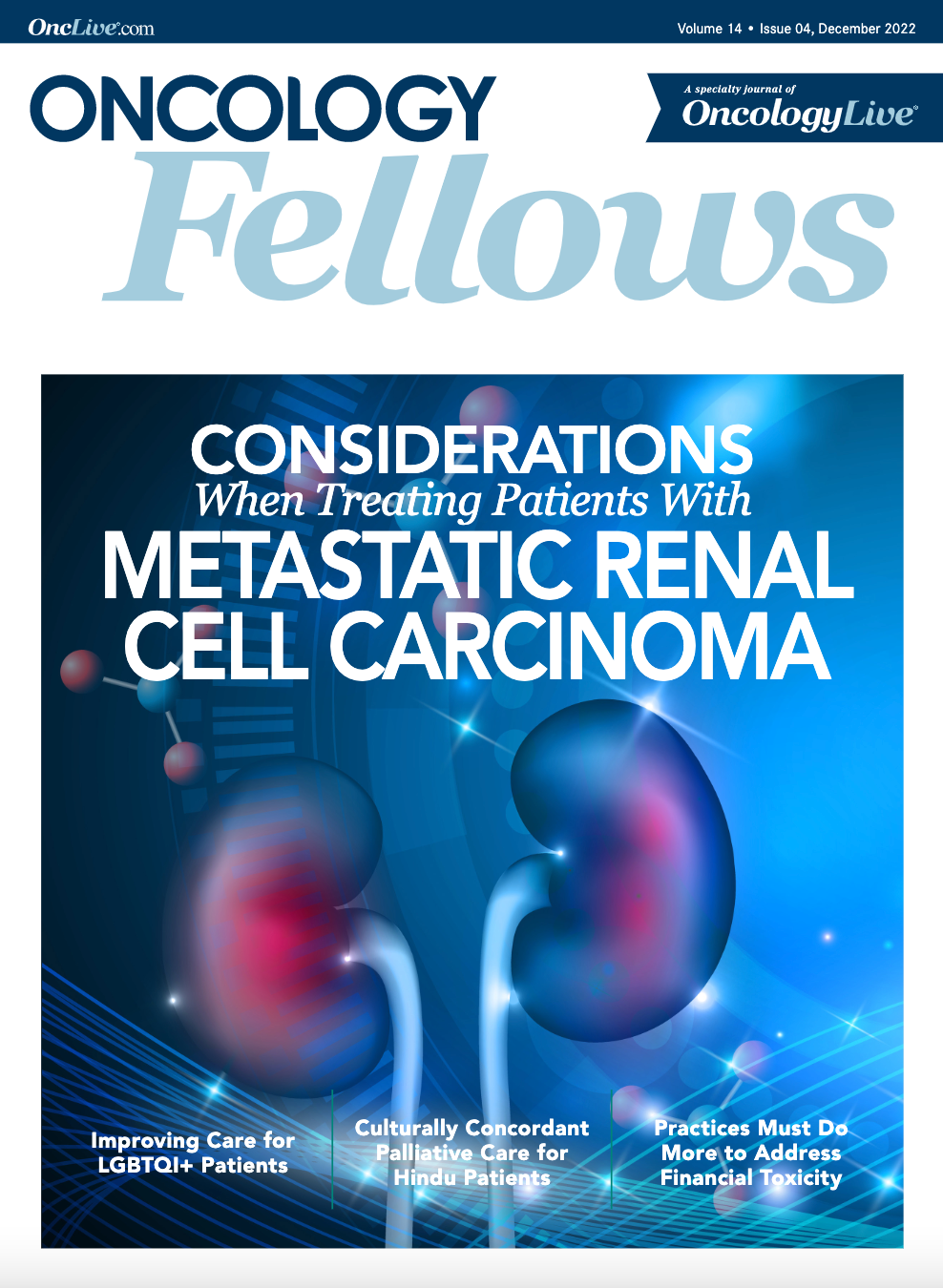How to Improve Care for LGBTQI+ Patients With Cancer
As more and more people in the United States identify as lesbian, gay, bisexual, transgender, queer, intersex, or other sexual orientation or gender minority, the population of LGBTQI+ cancer survivors is becoming uniquely heterogeneous.
Colin Burnett, MSc

As more and more people in the United States identify as lesbian, gay, bisexual, transgender, queer, intersex, or other sexual orientation or gender minority (LGBTQI+), the population of LGBTQI+ cancer survivors is becoming uniquely heterogeneous.1,2
Nevertheless, there is a paucity of research into or attention paid to the specific health care needs of this group, despite the medical community’s implicit understanding of the systemic barriers preventing these patients from receiving care equitable to that of their heterosexual, cisgender counterparts.
With the OUT: National Cancer Survey conducted by the National LGBT Cancer Network between 2020 and 2021, we reviewed the experiences of LGBTQI+ cancer survivors to better understand key areas of unmet needs in delivering optimal, patient-centered care along the care continuum.3 Based on analysis of data from the OUT survey, we created recommendations that may be easily implemented by oncologists and other personnel involved in the care of LGBTQI+ persons.
Ask Your Patients About Their Gender and Sexual Orientation
It may sound simple, but LGBTQI+ survivors reported that clinicians never asked about their sexual orientation throughout the whole of their care, and only 40% said that they were publicly identified as LGBTQI+. If providers don’t know a patient’s sexual orientation, they cannot contextualize the cancer information they share and the care they offer. Oncologists in particular are uniquely positioned to explain cancer occurrence and progression given their understanding of the pathophysiology involved.
A diagnosis of cancer may affect the mental and sexual health of LGBTQI+ patients differently than it does that of cisgender and/or heterosexual patients. Knowing a patient’s biological sex and sexual orientation would allow oncologists and care teams to make personalized recommendations about therapy and the mitigation of adverse effects.
For instance, men who engage in anal-receptive sex will face different challenges from colorectal or anal cancer than men who deny such sex.4 Transgender men may be at increased risk of breast cancer compared with cisgender men and may prefer different breast cancer treatments than cisgender women, especially in terms of surgical mastectomy versus hormone and/or chemoradiation therapy.
Regardless of diagnosis, it is important to consider how a patient’s LGBTQI+ identity may alter the way they interpret the news and the effects it will have on all aspects of their life. I encourage oncologists to ask about sexual identity when establishing care for patients with cancer.
When you don’t know if or how something may be different based on a patient’s sexual orientation or gender identity, ask them.
Ensure Medical Spaces Are Queer-Affirming and Reevaluate Frequently
Among survey respondents who felt less than satisfied with their overall cancer care, more reported feeling unsafe sharing their LGBTQI+ identities with their care teams (38%) than who reported felt safe (3%). Given that over 80% of patients did not intentionally seek care at an institution with a reputation for LGBTQI+ friendliness, providers and staff alike should make an effort to increase LGBTQI+ visibility at their institutions.
Easy ways to create more safe spaces include normalizing disclosure of pronouns by adding them to personnel identification badges, displaying pride flags openly in common spaces, and distinguishing between sex (the biological anatomy of a person at birth) and gender (the person’s chosen identification and expression) on patient-facing medical forms.
These changes create a layer of intentionality and active patient advocacy. All members of a care team should be taught by peers to understand the importance of these changes. If implemented successfully, these changes may also increase the likelihood that patients will feel comfortable sharing their LGBTQI+ identity without being prompted. Equally important, building trust by physically and verbally establishing LGBTQI+ friendly spaces can expedite and deepen the providerpatient relationship.
To ease the burden of widescale changes, institutions may consider establishing a focused LGBTQI+ cancer working group whose goals include bettering the experiences of LGBTQI+ cancer patients beginning with these recommendations. Preexisting LGBTQI+ or PRIDE employee groups may also be consulted to start the planning process.
Generate and Distribute Health Education Materials That Center LGBTQI+ People and Experiences
Our data overwhelmingly show that very few LGBTQI+ patients have ever received health resources tailored to their sexual orientation and/or gender identity as differing from those of heterosexual and/or cisgender persons. More than 82% of survivors reported that they had never received information about being a LGBTQI+ person with cancer. Despite never having had access to such materials, LGBTQI+ survivors considered them valuable, as shown by the data (Figure).
Figure. Availability and Value of Health Resources for LGBTQI+ Cancer Survivors3

LGBTQI+ people are diagnosed with cancer more frequently than non- LGBTQI+ people.4 Research findings show that this population uses tobacco and alcohol at higher rates than the heterosexual and/or cisgender population. The associations between tobacco use and alcohol use and increased risk for certain cancers are well-established.5 Oncologists have the opportunity to directly address the risks associated with identifying as LGBTQI+, tobacco/alcohol use, and cancer—and thus bolster the alcohol and tobacco cessation efforts of primary care providers.
The same logic applies to quality-of-life care during survivorship, especially when we consider the increased prevalence of mental health and psychiatric conditions among LGBTQI+ people. Distribution of resources tailored to them, their lifestyles, and their risks may improve their overall satisfaction with care from time of screening through longterm survivorship.
Create and Maintain LGBTQI+-Specific Dialogue in Cancer Survivor Support Groups
More LGBTQI+ persons were less than satisfied with their overall cancer care if they deemed it important to have (1) LGBTQI+ welcoming social support available and (2) LGBTQI+ information specified in their posttreatment care plans.
General survivor support groups focus on the experience of living with, or having had, cancer. LGBTQI+ patients may benefit from narratives within survivorship groups geared to their unique challenges. Better yet, they would benefit from LGBTQI+-focused groups, where they can enter the room knowing that others there are also part of their community. Interdisciplinary efforts from social work, case management, psychiatry, mental health counseling, and others may ease the administrative burden of these groups, but oncologists can start the conversation with patients and make the initial recommendation that they pursue these groups as part of their long-term care plan.
As we research further into the cancer journeys of LGBTQI+ persons, we will continue to glean information about how their experiences through cancer care may be improved. During one of the most difficult periods in a patient’s life, it becomes the responsibility of all care providers—the people patients trust—to make them feel safe, visible, and valued. And oncologists, who head these teams, should lead these efforts.
We cannot provide the highest quality of patient care to LGBTQI+ patients without appreciating the nuanced health challenges and differences that come with being a member of this community. Although these recommendations cannot be enacted overnight, with gradual integration and implementation, we may all contribute to improving cancer care for LGBTQI+ patients.




